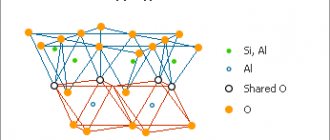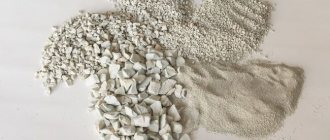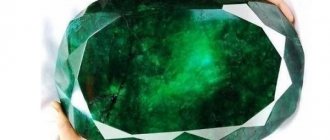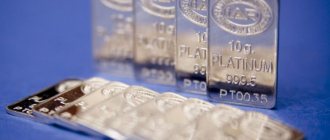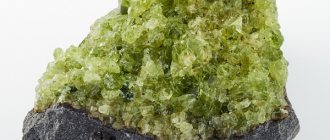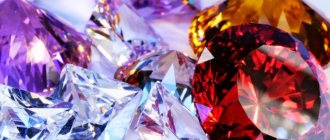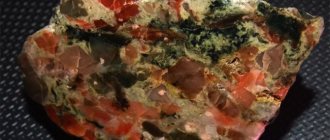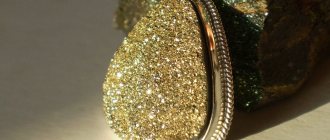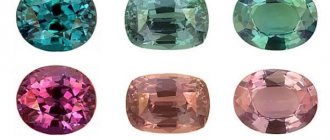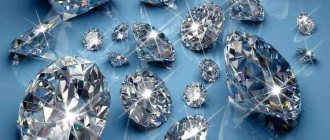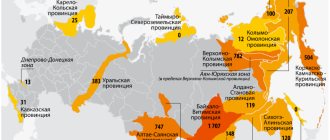Story
Linguists believe that the name comes from the word “layer”.
The history of the mineral is connected with Russia:
- In Rus', he was called “sluda,” which was recorded in the Ostromir Gospel (1057).
- After 500 years, windows made of “Moscow crystal” could be afforded by nobles, merchants, and wealthy church parishes.
- By the 17th century, mica windows began to be painted like stained glass windows in Western European temples.
- Even more popular were lampshades, lanterns, mineral inlay boxes, and other household items.
- Mica plates were used to protect icons and decorate church utensils.
Mica, called muscovite (foreigners then called Russia Muscovy), was considered the best in the world.
Mining the mineral was a profitable business: 16-140 rubles were paid for a pood (16 kg). And, for example, a cow cost 4-5 rubles.
Windows were “glazed” with mica plates before the invention of real glass (18th century).
Mica instead of glass
In 1887, Russian scientist Konstantin Khrushchev created artificial mica - fluorphlogopite. In a number of characteristics it is superior to natural gemstones. Only special equipment can distinguish one from the other. The invention was useful during the Great Patriotic War.
The most remarkable object outside of Russia is the Mexican city of gods Teotihuacan. Its buildings are lavishly decorated with minerals that were brought here 5,000 km away.
Trade in antiquity
The development of the mica industry in Karelia occurred at the beginning of the 17th century. The Moscow government in 1608 issued a Decree that obligated people to pay taxes on rock production. The price of the mineral sold depended on the variety. Miners of dark stone had to pay a tax on the sale of a natural resource in the amount of 1/10 of the total volume. At that time it was also called rock quartz or granite.
The Russian population living near mica deposits used the mineral. For example, residents of the Angara coast could collect it from the surface of the ground and sell it to merchants. The peasants did not have the opportunity to glaze the windows in their houses with mica. They also sold it.
Mica was bought by wealthy people of the East from Persian merchants, and in the West the mineral was sold by Frankish traders and merchants from Greece. Mica mined in Russia was called muscovite, that is, a derivative of the name of the capital of Rus' - Moscow. Russian stone has received worldwide recognition. After opening in the 18th century. They stopped covering window openings with mica sheets.
What is mica
This is a rock of volcanic or metamorphic origin. In nature it is represented by agglomerates of yellow, green, pink shades. Thanks to its layered structure, it is easy to distinguish from other minerals and synthetic imitation.
It is found in other rocks. For example, spar, mica and quartz form granite.
In aventurine, a precious variety of quartz, it is mica that creates the characteristic sparkles.
What is it like?
Based on the size of the grains, the following types of granite can be distinguished, namely:
- coarse-grained stone (over 10 mm);
- medium-grained granite (2-10 mm);
- fine-grained (less than 2 mm).
The color palette of granite is represented by almost the entire spectrum of shades. The multi-colored grains are feldspar, mica colors granite black, and quartz is responsible for the sparkling translucent grains.
Physico-chemical characteristics
Mica is a whole family of minerals with a general formula. But each has its own melting point, density and other characteristics.
General formula: X+Y23+[AlSi3O10](OH, F)2 , less often X+Y32+[AlSi3O10](OH, F)2 , where X is mainly K, less often Na, NH4, Y is usually Mg, Fe, Al, less commonly Ba, Mn, Ca, Ti, Zn, B, V, UO2.
According to chemical nomenclature, it is an aluminosilicate (like, for example, feldspar).
Interpretation of the concept
This group of minerals has perfect cleavage in one direction. They are capable of splitting into very thin hard plates, while maintaining elasticity, flexibility and strength.
Thus, we can conclude that mica is a mineral that visually resembles glass and has a structure of layered crystals. It is due to this feature, as well as due to the weak connection between individual packages of materials, that certain chemical properties are formed.
Regardless of the fact that there are many varieties of the mineral in question, it has common characteristics, such as:
- lamellarity;
- basal cleavage;
- the ability to split into the finest components.
Varieties of mineral
Based on composition, color, and other characteristics, the following main varieties of the mineral are distinguished:
- Biotite. Ferrous, opaque, black to brownish-green.
- Lepidolite. Translucent plates look like curved petals, sometimes forming “buds”-rosettes. Standard colors are lilac, pinkish-lilac, with faded yellow or grayish tint, colorless.
- Muscovite. The most common type. Colorless or whitish, half or completely transparent mica plates.
- Phlogopite. Yellow, sometimes brown. In the light, the “leaf” glows with golden or ocher hues. Second most common.
They are always mentioned when describing a specific sample or batch of mica raw materials.
Varieties are arranged according to the dominance of elements in the composition. Thus, paragonite and muscovite are aluminum mica. Biotite, phlogopite, lepidomelane – iron-magnesium, zinnwaldite and lepidolite – lithium.
Properties of muscovite
Features corresponding to this type of minerals lie in the structure of crystal irregularities. The unevenness of the outer part of the material fully corresponds to the unevenness inside it. The smoother the material, without chips, with the least number of plates, the better quality it is.
Electrical insulation is the main ability of this mineral
The main property of mica is its high electrical insulation - the ability not to conduct current and prevent the penetration of environmental conditions. The reflection spectrum of muscovite, which shows the energy of reflection, is also important.
The material has excellent ductility and flexibility. Its density is 2.83 g/cm³. It is practically not subject to melting, which shows resistance to high temperatures. Recognition of muscovite occurs due to its pearlescent luster, detachment of thin silver plates, velvety shine, elasticity, pleasant light tones of translucent white, cream, gray and yellow.
Areas of use
Mica has found use in industry, agriculture, beauty and collectors.
Mica in the microwave
Industry
The properties of mica have determined its demand in almost all sectors of the economic complex:
- Waste from the production of sheet material is ground. The powder is used in the manufacture of rubber, cement, plastics, varnishes, and paints.
- The mineral’s ability to remain an electrical insulator even at extreme temperatures has made it a valuable asset for radio electronics.
Various electrical mica products - In cosmetology, mineral cosmetics are created based on mica powder - creams, powder, blush, eye shadow.
- Vermiculite (expanded mica) is in demand by builders as a thermal insulator filler that maintains its condition for decades.
For farmers, the mica mineral is a “three-in-one” product that increases productivity significantly.
Soil enriched with vermiculite becomes a fertilizer with a complex of microelements, a substrate for growing seedlings, and prevents drying out of wet soil.
Jewelry and decor
The mineral is used to decorate the interior. They decorate panels, furniture, boxes, photo frames. Paints enriched with mica powder make the surface seem to shine from within. It is added to liquid wallpaper and facing plastic.
Mica cabochons become inserts into rings, earrings, pendants, and brooches.
It is popular among restorers who restore items made of ivory, mother-of-pearl, and valuable wood species.
Breed cost
In past centuries, the price of mica was in the range of 15–150 rubles. The cost increased with the underground mining method and depended on the rarity of the mineral and the distance between the buyer and the deposit.
Now the same criteria influence the price. Mica slate is sold from 100 rubles per stone. Collectible pieces start at $100. The price of the powder varies from 20 to 300 rubles per package.
Jewelry and products are priced in euros. Depending on the complexity of the work, they can be purchased for 5–6000 euros.
The mineral is valued by magicians, cosmetologists, manicurists, color therapy doctors, and folk craftsmen. Quite accessible in terms of availability and price.
What uses have you seen for mica? Share interesting facts, ask questions, comment and distribute the article on social networks. All the best.
Therapeutic effect
The properties of the mineral have long been studied and used by Indians and residents of other countries - adherents of the ancient teachings of Ayurveda. They claim that black mica that has been calcined becomes medicinal. The following method is recognized as the best: mica stones are moved over the sacred fire at least two hundred times. This medicine is especially helpful for gastrointestinal problems.
Today lithotherapists also process it - in electric furnaces. But the therapeutic effect of such a mineral is controversial, sometimes zero.
Powdered mica is prescribed to people who are weakened or have contracted an infection.
Stone mining methods
Mica occurs naturally in nature, but it can also be grown artificially.
If we talk about natural mining of the mineral, then 2 options are used, depending on the depth of its occurrence:
- Open. Suitable for stones located no deeper than 100 m. In this case, the quarry principle is used, when the top layer of the earth is drilled or exploded with dynamite, high-quality crystals are selected manually.
- Closed (mine). It is used in the extraction of mica at depths from 100 to 4000 m. Shafts and underground passages are laid to the location of the mineral, and the ground around the deposits is exploded or loosened with a drill.
In the process of producing synthetic stone, conditions are created that are as close as possible to natural ones: the temperature is kept within 1400 °C with a gradual decrease to 1200 °C, almost the same components are used as natural mica. The result is a fine crystal suitable for powder or small products.
Magical powers
The magic of mica is determined by the variety or color of the mineral:
- Stones of yellow-brown shades are an attribute of careerists, financiers and those who want to get rich.
- Green muscovite is a regulator of internal harmony.
- Pink is the stone of love . Suitable for people looking for their soul mate or seeking to revive a former passion.
- White or grayish muscovites are worn in cold weather to avoid freezing.
However, only natural mica stone is suitable as a talisman or amulet.
How to spot a fake
In order not to be deceived by the naturalness of mica (especially powder), sellers are asked to show certificates of conformity and quality of the mineral. Without the help of a gemologist or jeweler, it is almost impossible to distinguish between natural, synthetic and fake stones.
Natural mica plates can:
- bend at an angle of 90º;
- scratch with a fingernail;
- do not melt in the candle fire;
- be of uneven color;
- crack when compressed with a vice;
- contain inclusions of other minerals;
- be wavy, with voids and cracks inside.
Water is considered the most harmless home test method. The mineral is sprayed with water. The naturalness of mica is confirmed by drops that retain a hemispherical shape for more than 30 seconds and do not spread over the surface.
Origin and location
A common, chemically stable mineral.
Among the minerals of the mica group, it is widely distributed. As a rock-forming mineral, it is included in the composition of some intrusive rocks, in particular, in the composition of granites, especially greisen, i.e., pneumatolytically altered varieties of them, in association with topaz, lithium mica, quartz, sometimes wolframite, cassiterite, molybdenite, etc. In these cases, muscovite is formed mainly due to previously released potassium feldspars (orthoclase and microcline).
Relatively often found in granite pegmatite veins in the form of large crystals of industrial interest. Muscovite in such veins, especially in the central parts, often produces clusters in the form of nests up to 1–2 m in diameter, but is usually randomly scattered in the form of large crystals throughout the entire mass of pegmatite or along certain zones.
Zircon, rutile in the form of a saguenite lattice, apatite, spinel, garnets, tourmaline, quartz, magnetite, etc. are sometimes found as tiny inclusions in muscovite crystals. With a detailed study, in some cases, it is possible to establish certain patterns of orientation of these inclusions in accordance with the structural features of the minerals.
Muscovite is rare in contact-metasomatic deposits. There are known cases of the formation of fine-grained muscovite in sandstones at their contact with granites and other acidic igneous rocks.
Under hydrothermal conditions, sericite is usually formed due to the decomposition of spars (sericitization, i.e. the formation of sericite - a cryptocrystalline variety of mica enriched in water): 6KAlSi3O8 + 4H2O + CO2 + ZAl2O3 -> 4KAl2[AlSi3Oi0](OH)2 + K2CO3 + 6SiO2. Sericite is stable in neutral (weakly acidic or slightly alkaline) solutions at relatively high temperatures, while in more acidic solutions pyrophyllite and kaolinite are formed instead; the latter is a lower temperature mineral.
In metamorphic rocks, muscovite and sericite are widespread. Entire massifs of mica crystalline schists, sericite-containing shales (phyllites) and quartzites with muscovite are known. In such rocks, feldspars are usually absent, because being the initial source for the formation of muscovite micas under conditions of regional metamorphism.
During weathering processes it is relatively chemically resistant and often turns into placers. Due to its ability to easily split into small leaves and due to its low specific gravity, it usually accumulates in the form of tiny silvery sparkles in silty sediments and layered clays formed in water basins with slow water movement.
Under conditions of intense chemical weathering, muscovite is capable of transforming into hydromicas richer in water - hydromuscovite, and when passing into an alkali solution - into kaolinite.
Its virtues
Granite is a stone whose mica content makes it durable compared to the popular marble. Products made from it never lose their properties and are not externally deformed when used in a climate with a continental seasonal temperature difference of more than one hundred degrees. Thus, granite is not afraid of either sixty-degree frosts or heat above 50 degrees, which is important in the Russian climate. In addition, this stone is much less susceptible to fungal infections than marble.
Granite, which contains mica in the form of muscovite and biotite, is not only durable, but also a fireproof stone. It begins to melt at temperatures above 700 degrees Celsius.
You should also consider a criterion that determines the degree of strength, such as moisture absorption. Granite outperforms all its competitors.
Physical research methods
Differential thermal analysis. The DTA curve of muscovite shows three endothermic peaks at temperatures around 125, 860 and 1180° and one exothermic at 377°; the latter is caused by the oxidation of divalent iron.
Main lines on X-ray diffraction patterns: 10.04(10) - 5.02(5) - 4.48(6) - 4.46(5) - 3.35(10) - 2.56(8) (muscovite 2M1) ; 10.08(10) - 4.49(8) - 3.36(10) - 3.07(5) - 2.58(5) - 2.56(8) (muscovite 1M); 9.99(10) - 4.99(8) - 3.33(10) - 2.56(5) (muscovite 3T).
Ancient methods. It melts with difficulty under a blowpipe; in this case, a gray or yellow glass pearl is formed - white enamel. Water begins to be released only at a red-hot temperature (above 850 °C).
Interference coloring in thin section
